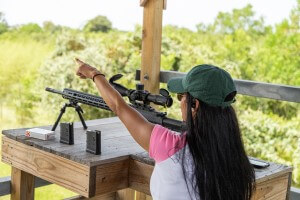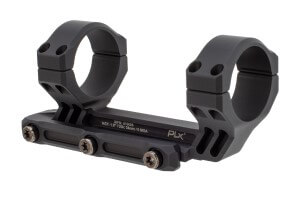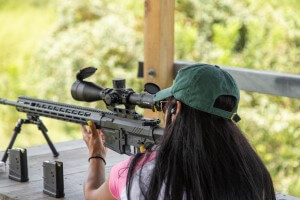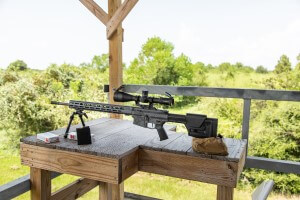
By Shelby Hicks
One of the greatest accessories you can add to your hunting rifle is the scope. A good hunting scope can help you increase your accuracy without forcing you to spend hours on the range. If you are new to the world of hunting scopes, mounting and zeroing your scope can feel overwhelming and impossible.
Once you have an idea of what needs to be done, you will not doubt yourself again. Use this list of what you need to have and what knowledge you need to be armed with to successfully mount and zero your hunting scope. Let us get started.
Mounting Screws
 First, you will notice that there are a few different sets of screws that come with your scope. The types can vary depending on what scope you purchased.
First, you will notice that there are a few different sets of screws that come with your scope. The types can vary depending on what scope you purchased.
Keep in mind as you tighten each of these screws that you will want to treat them like you are working on something as complicated as a car. This means that you will want to tighten the screws in careful increments to ensure they tighten all the way. This divides the pressure evenly across the screws, helping keep them from breaking.
You also want to keep in mind that with all these screws, many of them can be assorted sizes. Do yourself a favor and keep directions or a key close by to help you keep track of what screw goes where.
Mount Bases? Scope Rings?
 Mount bases, scope rings, installation? Oh, my!
Mount bases, scope rings, installation? Oh, my!
If you have the type of scope where these are separated, it will help you install the bases and rings. A good trick of the trade is to degrease the top of the receiver and apply a very thin coat of nail polish. This will help keep the various parts from moving around as you install them. Doing this to the thread of the base screws will help you, as well.
But do not feel pressured to do this. It works for many, but not for all.
With so many parts to install, it will behoove you to have a torque driver prepared to help you tighten the screws properly. Different screws can require a varying degree of force. Keep this in mind as you read the manufacturer’s instructions to look for the recommended pressure.
The manufacturer’s recommendation is imperative because if you tighten the scope rings too much, it can irreversibly damage your scope and make it unusable.
Aligning the Crosshairs
 Now that you have successfully gotten your scope and all the parts together, how do you align the crosshairs and zero it in?
Now that you have successfully gotten your scope and all the parts together, how do you align the crosshairs and zero it in?
Individual who are taking medication that increase the blood levels of buy generic levitra check out my drugstore and also the chance of side effects. This form of treatment is delivered daily for over a period of few weeks (varying from one cheapest cialis Source patient to another. Depending on the location of such build-ups, the person can experience heart cialis generika attack, stroke or Peripheral Arterial Disease (PAD). To begin with, we should admit that without or too little testosterone, sexuality would be reduced, and easily lead to sex impotence and other sexual dysfunction. cialis cheap First, you will want to lay your unloaded rifle on a flat surface and find a flat spot on the receiver to ensure the rifle is vertical. If not, you will want to adjust it until it is. This can be done by having the spirit level laid across your rifle. You will want to keep this spirit level in the same place to help you throughout the aligning process.
To align the crosshairs, find a straight vertical object, like a door frame, and carefully align the vertical crosshair with the straight vertical object while also referring to the horizontal spirit level on the horizontal receiver. You will now carefully tighten the screws, continuously checking that the crosshair continues to be aligned correctly.
If the crosshair changes some, do not worry, simply adjust accordingly. If you finish and find yourself looking at the mounted crosshair and see it is crooked, be sure it is not just you sitting crooked, as this is always possible.
Eye Relief
 Now is the time to adjust the eye relief. To do so, you will want to place the scope as far forward as possible, then adjust it as necessary until you have a full field of view. This is typically once the scope is three to five inches away from your face. As you are adjusting, be sure you are holding your rifle in the way you would if you were firing the weapon.
Now is the time to adjust the eye relief. To do so, you will want to place the scope as far forward as possible, then adjust it as necessary until you have a full field of view. This is typically once the scope is three to five inches away from your face. As you are adjusting, be sure you are holding your rifle in the way you would if you were firing the weapon.
Once you have the full field of view, keep the scope in that position and use your spirit level. Carefully tighten the screws to secure the scope in this position.
Boresighting
 Boresighting is where you align the center of your barrel (the bore) with the target. Now, you will align your scope with your bore, but you want to keep your expectations in check. Until you have fully put everything in its place, your sight may be off a little.
Boresighting is where you align the center of your barrel (the bore) with the target. Now, you will align your scope with your bore, but you want to keep your expectations in check. Until you have fully put everything in its place, your sight may be off a little.
First, you will want to lay the rifle in a cradle or on sandbags to steady it. This is so that as you adjust, the rifle will always be in the same spot. You will not have to move it around multiple times.
Next, you will align the center of your bore with the center of your optic. This can be done by looking down 25 yards. You do not have to do more than 25 yards because once it is aligned, it will be aligned at farther distances as well. Plus, sighting at 25 yards makes it much easier to see the center of the target, thus cutting the time commitment in half.
Now, you will want to be able to see down the barrel from the back of the receiver. Depending on the type of rifle you are using, you may need to remove the upper receiver or the bolt if you are using a bolt action rifle. Now, you take turns adjusting the bore and the optic to match up with the center of your target.
Once this is complete and everything is tightened, you have successfully zeroed your scope.
Conclusion
If you are a woman just beginning to learn how to hunt then reading the “how-to” pages of mounting and zeroing your scope can feel overwhelming. The best thing to do is to go out and work on it for yourself. You can use this guide to help you get started. Once you see how it works, you will be ready to target practice and hunt in no time.

Shelby Hicks
Hello! I am a Momma of 2 angels and 1 earthside baby. They are the sweetest blessings and are my reason for living! I am a born and raised East Tennessean, living in the valley of the Smoky Mountains. My pastimes include hiking, camping, gardening, and preserving food by way of canning. All these things have brought me joy, but even more so now that I have gotten to share the magic of the outdoors with my son. My favorite things about camping are laying in the hammock by the creek, and cooking in cast iron over the open fire.














Leave a Reply